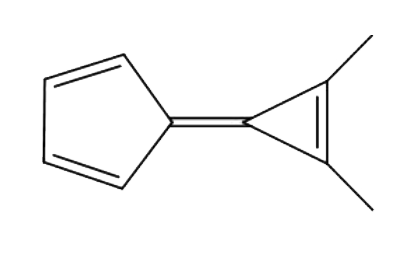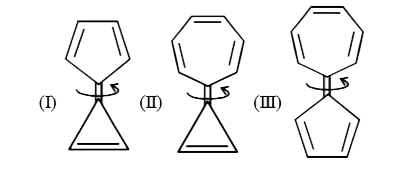Why free rotation about a -bond is not possible ?
Step-by-Step Solution:
1. Understanding Bonds:
- In chemistry, bonds between atoms can be classified into two main types: sigma (σ) bonds and pi (π) bonds.
2. Formation of Sigma Bonds:
- Sigma bonds are formed by the head-on or end-to-end overlap of atomic orbitals. This can involve s-orbitals, p-orbitals, or hybrid orbitals.
- The overlapping occurs in such a way that the electron density is concentrated along the axis connecting the two nuclei.
3. Free Rotation Around Sigma Bonds:
- Due to the nature of sigma bonds, which allow for this end-to-end overlap, there is no restriction on the rotation around the bond axis.
- Therefore, free rotation is possible around sigma bonds, allowing the connected atoms to rotate freely without breaking the bond.
4. Formation of Pi Bonds:
- Pi bonds, on the other hand, are formed by the side-to-side overlap of p-orbitals.
- This overlap occurs when two p-orbitals align parallel to each other, creating a bond above and below the plane of the nuclei of the bonding atoms.
5. Restriction on Rotation for Pi Bonds:
- The parallel orientation of the p-orbitals means that if one atom tries to rotate around the bond axis, the overlap of the p-orbitals would be disrupted.
- This disruption would break the pi bond, making free rotation impossible.
6. Conclusion:
- Therefore, the inability to rotate freely around a pi bond is due to the nature of its formation through parallel overlapping of p-orbitals, which restricts rotation without breaking the bond.
- In chemistry, bonds between atoms can be classified into two main types: sigma (σ) bonds and pi (π) bonds.
- Sigma bonds are formed by the head-on or end-to-end overlap of atomic orbitals. This can involve s-orbitals, p-orbitals, or hybrid orbitals.
- The overlapping occurs in such a way that the electron density is concentrated along the axis connecting the two nuclei.
- Due to the nature of sigma bonds, which allow for this end-to-end overlap, there is no restriction on the rotation around the bond axis.
- Therefore, free rotation is possible around sigma bonds, allowing the connected atoms to rotate freely without breaking the bond.
- Pi bonds, on the other hand, are formed by the side-to-side overlap of p-orbitals.
- This overlap occurs when two p-orbitals align parallel to each other, creating a bond above and below the plane of the nuclei of the bonding atoms.
- The parallel orientation of the p-orbitals means that if one atom tries to rotate around the bond axis, the overlap of the p-orbitals would be disrupted.
- This disruption would break the pi bond, making free rotation impossible.
- Therefore, the inability to rotate freely around a pi bond is due to the nature of its formation through parallel overlapping of p-orbitals, which restricts rotation without breaking the bond.
Topper's Solved these Questions
- CHEMICAL BONDING AND MOLECULAR STRUCTUREBOOK - PRADEEPCHAPTER - CHEMICAL BONDING AND MOLECULAR STRUCTUREEXERCISE - ADDITIONAL QUESTIONS (SHORT ANSWER QUESTIONS)
62 Videos
- CHEMICAL BONDING AND MOLECULAR STRUCTUREBOOK - PRADEEPCHAPTER - CHEMICAL BONDING AND MOLECULAR STRUCTUREEXERCISE - ADDITIONAL QUESTIONS (LONG ANSWER QUESTIONS)
13 Videos
- CHEMICAL BONDING AND MOLECULAR STRUCTUREBOOK - PRADEEPCHAPTER - CHEMICAL BONDING AND MOLECULAR STRUCTUREEXERCISE - NCERT EXAMPLAR PROBLEMS ( MULTIPLE CHOICE QUESTIONS BASED ON THE GIVEN COMPREHENSION )
4 Videos
- APPENDIXBOOK - PRADEEPCHAPTER - APPENDIXEXERCISE - MODEL TEST PAPER <br> (Section C )
9 Videos
- CLASSIFICATION OF ELEMENTS AND PERIODICITY IN PROPERTIES BOOK - PRADEEPCHAPTER - CLASSIFICATION OF ELEMENTS AND PERIODICITY IN PROPERTIES EXERCISE - Competition Focus (Jee Main and Advanced / Medical Entrance ) ( Assertion - Reason Type Question ) (Type II)
12 Videos
Similar Questions
Assertion : Both rhombic and monoclinic sulphur exist as S8 but oxygen exists as O2.
Reason : Oxygen forms pπ−pπ multiple bond due to small size and small length but pπ−pπ bonding is not possible in sulphur.
View SolutionAssertion : Both rhombic and monoclinic sulphur exist as S8 but oxygen exists as O2.
Reason : Oxygen forms pπ−pπ multiple bond due to small size and small length but pπ−pπ bonding is not possible in sulphur.
View Solution
Knowledge Check
pπ−pπ bonding is possible in
ANBPCAsDSbdπ−pπ bonding is possible in
ANO−3,NO−2,N3−,CN−BNH3,PH3,BiH3CP2O3,P2O5,PO3−4DCO,NO,CO2,NO2Ordinarily the barrier to rotation about a carbon - carbon double bond is quite high but in compound P double bond between two rings was observed by NMR to have a rotational energy barrier of only about 20 cal/mol., showing that it has lot of single bond character.

The reason for this isADouble bond having partial triple bond character because of resonanceBDouble bond undergoes flippingCDouble bond having very high single bond character because of aromaticity gained in both three and five membered rings.D+I effect of nC3H7 groups makes double bond having partial single bond character.
Back bonding is possible in
View SolutionStatement-1:Restricted rotation about a bond is the necessary condition for geometrical isomerism.
Statement-2:Two different orientations are possible due to restricted rotation about a bond it the end groups are different .
View SolutionAmong the following which will have the least hindered (restricted) rotation about carbon carbon sigma and pi bond?
View SolutionWhich of the following will have the least hindered rotation about carbon-carbon bonds?
View Solution
The barrier for rotation about the indicated bonds
Will be maximum in which of these three compounds ?
View Solution
